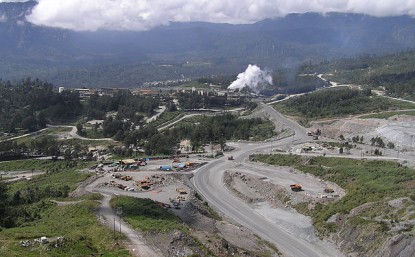
1. Gold is the world’s ultimate asset. So, even when nothing important is occurring in the market, investors can experience “ultimate greed” or “ultimate fear”.
2. Because the quality of the asset is so high, it’s crucial that investors are emotionally able to buy gold when uncertainty or even outright fear is present.
3. I have sarcastically suggested that US President Obama’s most successful program has been “Obombacare”. Horrifically, the United States government has borrowed trillions of dollars that it could not afford to borrow, and wasted it on endless wars in the Mid-East.
4.Please click here now. That’s the latest COT report for gold, and the huge buildup of commercial bank short positions can cause significant nervousness amongst amateur gold investors.
5. That’s because these short position buildups are often followed by somewhat violent price declines. History has shown that these declines are solid buying opportunities for courageous gold investors.
6. Please click here now. That’s the daily gold chart, and the technical situation is superb.
7. Gold burst upside from a symmetrical triangle pattern, as I predicted it would, and a painful pullback to the apex (about $1130 in this case) is typically the next technical event to occur.
8. The banks are likely anticipating this pullback, and adding short positions to profit from it. Gold is showing tremendous resiliency after the breakout.
9. Please click here now. The US dollar versus Japanese yen chart is used by FOREX traders as a key lead indicator for gold prices. The dollar is beginning to look a bit shaky on this daily bars chart.
10. Janet Yellen has tapered the QE program to zero, while her Japanese counterpart has engaged in aggressive QE, but the dollar has lost momentum against the yen anyways!
11. For another look at that chart, please click here now. It appears that the dollar is carving out a huge head and shoulders top pattern against the yen, and a breakdown should initiate a massive rush into gold by top FOREX money managers.
12. It’s important to remember that during the August – September global stock markets mini crash, it was the yen, not the dollar, that acted as the world’s fiat safe haven of choice.
13. The gold-related news coming out of China is also very positive. The PBOC-controlled Shanghai Gold Exchange (SGE) is preparing to launch a gold price fix, and the PBOC itself has started a very transparent monthly gold buy program.
14. Please click here now. The sell-off in Chinese stock markets has had no effect on gold demand. Demand is rising again!
15. I’ve been a “lone wolf” advocate of the gold monetization program in India, as I’ve been an advocate of American rate hikes. Both are bullish for gold. Rate hikes will incentivize banks to make more loans, which will reverse US money velocity. In India, monetization is creating a “hallmarking stampede”. It’s boosting overall demand for gold, because consumers can now buy professionally hallmarked jewellery. That was hard to get before the monetization plans were announced.
16. The math is pretty simple; if Indian consumers were buying 19 carat jewellery with a 22 carat label on it before hallmarking became popular, they can buy a lot more gold now, for the same price they paid in the past.
17. Jewellers are incentivized to move more volume, which is a win-win situation for all stakeholders, including the mines the Western gold community is heavily invested in!
18. 2016 should be a spectacular year for anyone involved with gold. While China is adding transparency to central bank operations in the gold market, India is adding transparency and to the gold jewellery market, and making the jewellery fungible.
19. Indian Dore bar imports are surging, and numerous Indian refiners are on the cusp of gaining LBMA certification for quality. The supply created by monetization is very small compared to the demand being created by the expansion of the jewellers.
20. The next FOMC meeting gets underway today, and Janet’s recent statements show her clear desire to see inflation move higher.
21. Please click here now. That’s the daily oil chart. Oil is the largest component of most commodity indexes, and Janet can’t be very happy about the price of oil. I expect her to make more references to the need to raise the level of inflation, at tomorrow’s FOMC meeting.
22. The good news is that oil appears to be forming a beautiful double bottom pattern. US rig counts are at a five year low, and oil investors are generally demoralized. In contrast I’m a happy buyer. I think 2016 will develop into a good year for oil, and for the broad-based commodity indexes.
23. Please click here now. That’s the daily silver chart. There’s a very bullish potential inverse head and shoulders bottom pattern in play. A scary sell-off now would build the right shoulder, and set the stage for a nice move higher to ring in the New Year!
24. Gold stocks also are making investors nervous this week, but I think they also need a bit of a sharp drop, to complete patterns that are similar to what is on the silver chart. On that note, please click here now. That’s the GDX daily chart.
25. A pullback to the $15 area, or a bit lower, would be very healthy price action. I predicted this was likely a week ago, and it seems to be in play now. Silver tends to perform better than gold when inflation is rising, and so do gold stocks. I think that’s very likely to happen, in 2016!
Stewart Thomson of Graceland Updates, Guest Contributor to MiningFeeds.com
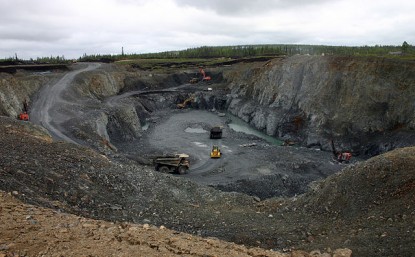
We published a video update a few days ago discussing the short-term outlook for the precious metals sector which includes the gold miners. With regards to the miners, we took the view that they could digest recent gains and hold support or break lower and trade close to the support near summer lows. After this week and today especially, one scenario is more likely.
We plot the daily candle charts of GDXJ and GDX below. There are numerous bullish points to make. First, the miners tested and held above support in each of the past five days. That culminated with a strong intraday reversal today (Friday). Second, the miners held above their 38% retracements which indicates they are holding most of their recent gains. Third, the miners will close today above their late August peaks. Fourth, the miners have held gains in the face of a very strong US Dollar.
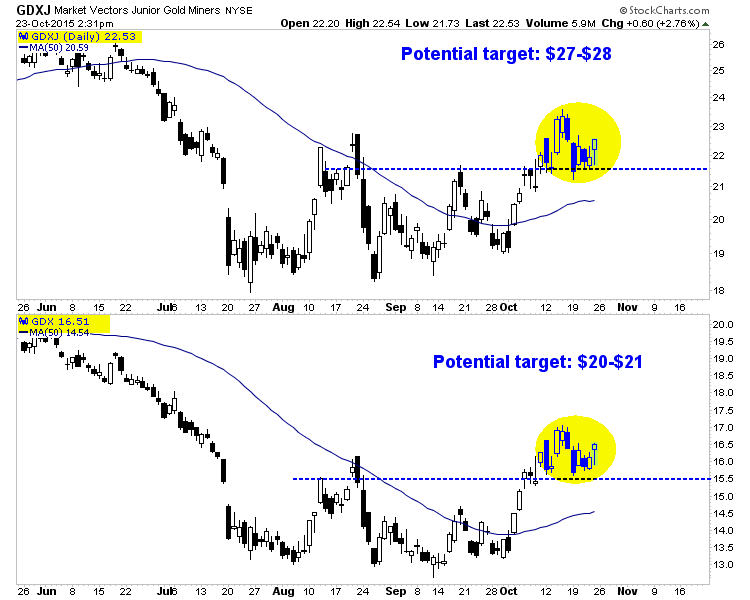
The miners have formed potential cup and handle patterns with the handle depicted in yellow (above). The potential upside targets are $27-$28 for GDXJ and $20-$21 for GDX. These targets are possible and would become probable should the miners break above their 200-day moving averages at $17.82 for GDX and $23.52 for GDXJ.
The next chart is a long-term look that includes the very significant 400-day moving averages. The aforementioned potential cup and handle targets nearly equate to the 400-day moving averages which need to be breached before a bull market can be declared. The 400-day moving average contained GDXJ’s peak in 2014 and GDX’s peaks in 2014 and 2015.
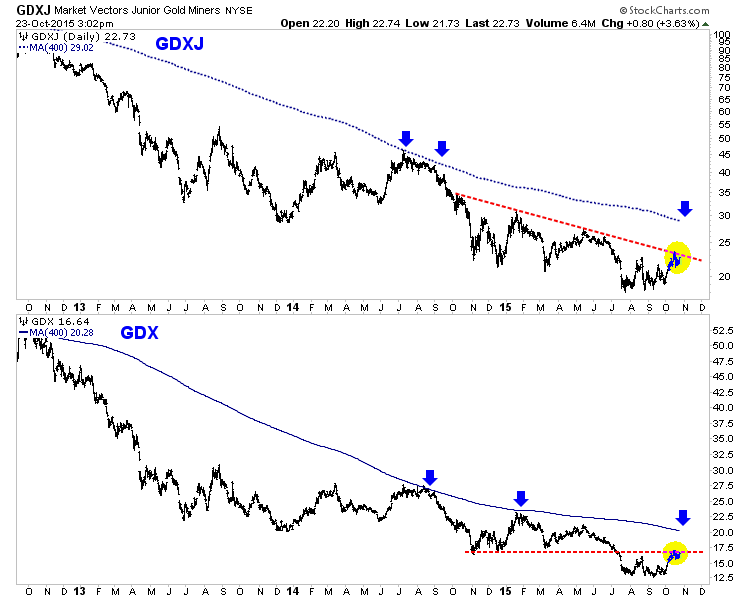
The miners’ holding of support for five consecutive days in the face of a surging US$ and a lack of strength in metals prices has increased the odds of the bullish scenario playing out. After enduring a devastating bear market the miners should be ripe for a recovery at some point. Need we mention that the gold stocks have been in their worst bear market ever and second longest? Need we mention that senior miners have been in a bear market for almost five years while junior miners have been in a bear market for four and a half years? The near term outlook looks bullish and if that plays out one would have to think a major long-term turn was at hand. As we navigate the end of this bear market, consider learning more about our premium service including our favorite junior miners which we expect to outperform into 2016.

Merger of URI & Anatolia Energy almost over the finish line
Colorado based Uranium Resources, Inc. “URI” (Nasdaq: URRE) announced that Anatolia Energy shareholders overwhelmingly approved the merger with Anatolia Energy. The expected closing is November 9, 2015. URI shareholders will own 59.4% and Anatolia shareholders 40.6%. More recently, On October 22nd, URI and Anatolia jointly announced that the Federal Court has granted orders approving the schemes of arrangement between Anatolia and URI. The Company intends to file the orders with the Australian Securities and Investments Commission on October 23rd, at which time the orders will take effect.
At that time, the Company will make a detailed announcement in relation to the merger, including confirming the timetable. The merger creates a dual-listed (NASDAQ + ASX) company with one of the lowest Enterprise Value, “EV” per in-situ pound/uranium ratios. A potential re-rating could be at hand as URI advances the Temrezli low-cost, high-grade, ISR project towards production is in the cards. Implicit in the above mentioned, favorable EV/Uranium ratio is the assumption that URI is sitting on massive resources, (Not NI 401-101 compliant) in the U.S. I have made that critical assumption and believe that it’s not unreasonable to do so.
In my interview of Christopher Jones, President and CEO of Uranium Resources, Inc. the focus was largely on the tremendous Temrezli ISR project. The combined company will hold a 100% interest in 9 licenses covering over 44,479 acres, (~18,000 hectares), including several advanced exploration opportunities in the central Anatolian region of Turkey. Initial production from Temrezli in the next 18 months or so is extremely important. Consider that China has 25 nuclear reactors under construction on top of its 26 operational reactors with plans to place a lot more into the construction phase. According to the World Nuclear Association, 43 additional reactors are planned and 136 proposed. Again, that’s in China alone.
URI’s Temrezli ISR project in Turkey is world-class, it does not require a meaningful increase in the uranium price to be profitable.
Uranium Resources Inc. (Nasdaq: URRE) has approximately 17,000 acres, (~ 6,880 hectares) of prospective In-Situ Recovery (ISR) prospects in Texas. In New Mexico, the Company holds a federal Nuclear Regulatory Commission license to recover up to three million pounds of uranium per year using the ISR process at the Churchrock-Crownpoint projects. The Company controls mineral rights encompassing approximately 76,890 hectares (190,000 acres) in the prolific Grants Mineral Belt in New Mexico. New Mexico is endowed with one of the largest concentrations of sandstone-hosted uranium deposits in the world.
In reviewing my notes on URI and ongoing conversations with management, I believe that several very important attributes need to be reiterated. I’m confident that most readers are unaware of these facts. First, the Company is a past producer, not an explorer or developer. URI has produced approximately 8 million pounds of uranium over the years as one of the oldest U.S. uranium names around. While not currently producing given current weak uranium prices, the Company has meaningful production experience and two licensed 800,000 pounds/year processing facilities on standby in Texas. The Company expects to relocate one plant for use at Temrezli, reducing capital costs there, and has a second plant ready to jump back into production once uranium prices rebound.
Second, speaking of vast experience, the management and Directors form a highly seasoned team, one of the best among juniors and mid-tier peers.
Third, the combined company will have far better access to funding and stronger trading liquidity on both the NASDAQ and Australian markets. There are many Australian-listed uranium companies including Paladin Energy, Toro Energy, Peninsula Energy Ltd., Energy Resources of Australia Ltd. each with market caps comfortably above US$ 100 million. The pro forma and existing largest shareholder, Resource Capital Fund, “RCF,” voted in favor of the merger and has the financial wherewithal to participate in funding initiatives, (at the project level, or extending relatively non-onerous debt). Alex Molyneux, Chairman of Azarga Uranium, had this to say, “I am a big supporter of Anatolia’s Temrezli project. It’s the world’s lowest cost, undeveloped uranium project, now in the hands of an experienced ISR team with demonstrated financial support from RCF.”
Funding of Temrezli should not be that difficult, URI could become a takeout target by next year
To be clear, project financing of Turkey’s Temrezli is yet to be determined. Management is looking at a variety of financing alternatives including long-term supply contracts to utilities. In addition to RCF there are numerous uranium players, both producing and not, that could be interested in acquiring URI outright. Energy Fuels has been in acquisition mode, recently acquiring Uranerz Energy Corp. A key consideration in any takeout scenario is that Turkey would represent both geographic and project level diversification to any suitor. For example, Toro Energy has a few projects in Australia that probably won’t reach for production for 5+ years.
Fourth, URI has 119 million pounds of non-reserve, non reserve mineralized material and a NRC license to produce up to 3 million pounds per year. In my opinion, this is a crucial factor holding URI’s stock back. I believe that the in-ground resources are a free option in URI’s current valuation, representing hidden assets that could become more tangible and valuable over time. Note that URI’s deposits are in the prolific Grants Mineral Beltin New Mexico one of the foremost uranium basins in the world. URI has also expanded its feeder pipeline of high-potential ISR projects in Texas, near its processing infrastructure.
Anatolia’s Pre‐Feasibility Study indicated an after-tax NPV of US$126 million (based on a uranium price of US$65/lb. and a discount rate of 8%). Assuming a uranium price of US$ 55/lb. the after-tax NPV is still a respectable ~ $80 million, twice the EV of the combined company. Therefore, investors get exploration targets in Turkey and ALL the Texas & New Mexico assets for free, a long-term call option on the uranium price breaking sustainably through $55/lb. in 2017-18. Recall that the Temrezli project is profitable at $40/lb., with all-in costs of roughly US$ 30/lb, placing the project squarely in the lowest cost quartile. Temrezli’s cash flow could be used to fund select Texas and New Mexico projects.
URI Management and Board members for a detailed list, please see here.
Conclusion
Investors seeking to articulate pure-play exposure to uranium stocks should take a closer look at Uranium Resources, Inc. The company is close to closing its merger with Anatolia Energy. The combined company has substantial near-term and long-term potential. With an EV of about US$ 40 million, (half that of Turkey’s Temrezil NPV), investors are getting a free option on significant assets in Texas and New Mexico, not to mention a free option on a more rapid bounce in the uranium price. URI’s Temrezil ISR project is world-class by any measure, suggesting that a number of larger uranium companies could be kicking the tires.
Disclosure: Uranium Resources Inc. has a small market cap. Small market cap stocks are highly speculative, not suitable for all investors. I, Peter Epstein, own shares of Uranium Resources Inc. purchased in the open market. Mr. Epstein, CFA, MBA is not a licensed financial advisor. Readers should take that fact into careful consideration before buying or selling any stocks.
Readers are encouraged to consult with their own investment advisors before buying or selling any stock, especially speculative ones like Uranium Resources Inc. At the time that this article was posted, Uranium Resources Inc. was a sponsor of: http://EpsteinResearch.com. Please consider visiting: http://EpsteinResearch.com for free updates on URI and others across a range of sectors. While at http://EpsteinResearch.com, please enter an email for instant delivery of my work. Thank you for supporting my articles & interviews.

1. Canada has a new Prime Minister. His name is Justin Trudeau.
2. “Trudeau has pledged to run small budget deficits and spend on infrastructure to stimulate economic growth, which has been anemic for years. He has also promised to raise taxes on high-income Canadians and reduce them for the middle class.” – Reuters News, October 20, 2015
3. I have sarcastically suggested that US President Obama’s most successful program has been “Obombacare”. Horrifically, the United States government has borrowed trillions of dollars that it could not afford to borrow, and wasted it on endless wars in the Mid-East.
4. In contrast, China has spent and committed enormous amounts of borrowed money to infrastructure spending, and so has India.
5. Canada has now clearly chosen to follow the Asian model, leaving America and Europe to fall even further by the “new era wayside”.
6. As a result, I’m immediately issuing a prediction for the Canadian dollar, to begin a major rising trend in 2016.
7. Please click here now. Chinese demand for commodities related to domestic consumption (like oil) is not falling. It’s relentlessly rising.
8. Oil is not a huge play for me, but it is a decent asset, and it is on sale. I expect oil to rise 50% to 100% over the next 18 months, and I’m a very enthusiastic buyer of oil stocks.
9. Please click here now. Chinese oil companies are poised for a big rebound, but most US oil companies should also take part in the coming “upside fun”.
10. China is staging a planned and highly successful transition from an exports oriented economy, to one focused on domestic consumption.
11. In my professional opinion, China is going to accomplish in three years, what it took the empires of the past (including America and England) to accomplish in thirty years, in similar transitions.
12. Please click here now. Over the past several years, numerous statements and documents have been released by the PBOC (Chinese central bank), about the internationalization of the yuan, and the key role of gold in making that happen.
13. Please click here now. That’s the daily gold chart, and it looks magnificent.
14. After a breakout from a triangle pattern, a pullback to the apex (about $1130 in this case) is always likely, but please click here now. That’s another look at the same gold chart.
15. It’s clear that a possible bull pennant pattern is forming, with fairly dramatic upside implications for the price of gold.
16. I realize that I was pretty much alone in the Western gold community, in predicting that a massive rally would begin when the last jobs report was released at 8:30AM on October 2nd, but that’s exactly what happened.
17. Now, I’m going to go out on a second limb, and ask the community to be open to what is best termed as, “a momentum-fuelled phase transition”, to aneven stronger rally.
18. Please click here now. That’s the daily silver chart. The flag-like pattern in play now, comes after a key breakout from an inverse head and shoulders pattern.
19. I’m a keen owner of silver and silver stocks, which are now poised to begin outperforming gold. Silver enthusiasts don’t need to own more silver than gold to benefit from a period of outperformance by silver. They just need to own a decent amount of this mighty metal.
20. If gold’s rally does extend now, gold stocks should also extend their rally. Please click here now. That’s the daily GDX chart.
21. Many gold stocks have rallied 100% and more, from the September lows, and GDX itself is up significantly. A pullback is welcome, expected, and adds to the positive technical picture.
22. Using Fibonacci retracement lines, a 50% pullback would put GDX at just under $15.
23. More importantly, that pullback would create a bullish right shoulder of an inverse head and shoulders bottom formation.
24. Note the enormous volume that has occurred since mid-July. It’s clear to me that GDX and its underlying gold stocks are moving directly from weak hands to very strong ones. If GDX does trade under $15 this week, I’d like to see the entire Western gold community pressing their gold stock buy buttons, in unison!
Stewart Thomson of Graceland Updates, Guest Contributor to MiningFeeds.com
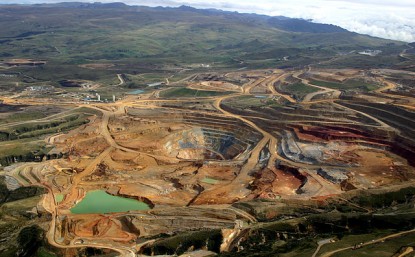
Despite gold blasting higher this month, this metal remains deeply out of favor among investors. They have shunned it for years thanks to extreme central-bank money printing levitating stock markets. This slayed demand for alternative investments, led by gold. But the resulting radical underinvestment in gold today is super-bullish. Vast capital inflows will be necessary to return gold investment to normal levels.
It’s impossible to overstate just how much gold is hated these days. Investors’ opinions on it range from total apathy to fervently believing gold is the worst investment on Earth. You can easily test this out in your own social circles. The next time the markets or investing come up, ask if gold is now a good buy. Everyone will say no, usually emphatically. And if you advocate for gold, they’ll think you’re naive or stupid.
This extreme gold antipathy is the natural consequence of this metal’s terrible price action in recent years. Between August 2011 and August 2015, gold lost 42.8% in a brutal secular bear market. Over that same span, the flagship S&P 500 stock index soared 86.8% largely thanks to the Federal Reserve’s epic QE3 debt-monetization campaign. And this recent history of gold getting slaughtered is all most traders remember.
But like all markets, gold is forever cyclical and never moves in one direction forever. Bear markets are inevitably followed by bull markets. And those mighty bull markets are always born in the darkest depths of despair when gold looks hopeless. The last time gold suffered from universal disdain similar to today’s was in the early 2000s. And that very extreme bearishness sowed the seeds for an enormous bull.
Between April 2001 and August 2011, gold skyrocketed 638.2% higher! It was the best-performing asset class over that decade, obliterating the S&P 500’s dismal 1.9% loss over that span. It is utterly amazing that investors have forgotten in recent years how incredible gold bulls are for multiplying wealth. And the time to buy low is after a long bear when prices are low and everyone believes they will stay that way forever.
This latest gold bear was totally artificial, conjured by the Federal Reserve’s extreme market distortions. Back in early 2013, the Fed ramped up its wildly-unprecedented open-ended third quantitative-easing campaign. Since QE3 had no predetermined size or end date like QE1 and QE2, it had a vastly greater impact on stock-market psychology. Traders came to believe the Fed was effectively backstopping stock markets.
Every time the stock markets threatened to slide in a normal healthy selloff, the FOMC itself or top Fed officials would jawbone about their willingness to ramp the extreme QE3 money printing if necessary to arrest the selling. So traders aggressively bought on this incredible Fed dovishness, ignoring normal indicators of overextended, overbought, and overvalued stock markets. The Fed levitated the stock markets!
Their massive Fed-fueled rally dwarfed everything else, with stocks’ performance sucking vast amounts of capital out of other assets including gold. Traders love to buy winners and chase rallying markets, so everything else withered. This ultimately led to today’s radical underinvestment in gold, with capital in this asset class far below normal levels. Like all market extremes, this one will inevitably mean revert too.
As gold is an opaque global market, there’s no way to directly measure total gold investment. Since gold enjoys inherent intrinsic value, and is physical and private, it can’t be tracked at the investor level. But gold investment can be inferred through a variety of metrics including national imports and exports. Of particular interest today is American investors’ level of gold investment, since they control such vast capital.
While American contrarian investors still prefer owning physical bullion coins in their own possession for a variety of excellent reasons, mainstream investors have gravitated towards a new vehicle. When they want gold exposure in their portfolios, they turn to the flagship GLD SPDR Gold Shares gold ETF. It is the world’s largest gold ETF by far, and utterly dominates American stock investors’ gold holdings.
GLD offers many advantages that really appeal to mainstream investors. It is a super-cheap way to get gold exposure, with a trivial 0.4% annual expense ratio about an order of magnitude smaller than the commissions on traditional coin purchases. And investors can buy or sell gold instantly via GLD, which holds the underlying physical gold bullion in trust for its shareholders. GLD is the most efficient way to own gold.
This is especially true for large investors like pension funds, mutual funds, and hedge funds. It’s just too impractical and expensive for them to deploy large amounts of capital in physical bars or coins. Not only would they have to worry about high commissions, but transfer, storage, and ongoing security. So the birth of GLD in November 2004 effectively opened up large gold investment to the entire fund industry.
GLD is incredibly transparent, publishing a comprehensive list of every single gold bar it holds in trust for its shareholders every day. The latest list this week was a whopping 1102 pages long! By studying the value of GLD’s gold bullion over longer periods of time, we can gain priceless insights into the levels of gold investment by large American investors. And these days they remain radically underinvested in gold.
This first chart looks at the value of GLD’s holdings, a great proxy for gold investment among American stock traders, superimposed over gold. It is simply computed by multiplying GLD’s daily holdings by the price of gold. And thanks to the combination of recent years’ gold bear along with the epic mass exodus from GLD by stock traders spawned by the Fed’s stock-market levitation, GLD investment is now super-low.
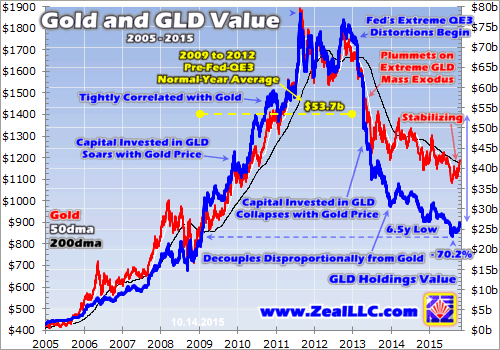
As of the middle of this week, the total amount of capital American stock traders had deployed in gold via GLD was just $26.5b. Despite gold’s sharp October rally, that wasn’t far above the major secular 6.5-year low of stock-market gold investment of $23.3b in early August. The last time gold investment was that low was in January 2009 when gold was trading near $855. This is what radical gold underinvestment looks like.
While $25b is a lot of money, it is vanishingly small in the grand scheme of investors’ capital. As of the end of September, fully 169 of the 500 companies in the S&P 500 had market capitalizations over $25b. The collective market capitalization of all 500 of those companies in that index was $17,581b. So $25b in gold via GLD is practically nothing, literally a rounding error. American investors really have shunned gold.
Stock traders’ incredibly-low levels of gold exposure today are best understood through the context of the history of GLD holdings’ value. The extreme weakness plaguing gold in recent years started in early 2013 as the Fed ramped up its unprecedented QE3 campaign. And 2008 of course saw that once-in-a-century stock panic that spooked the central banks into their current mode of extreme interventionism.
So the last normal years sandwiched between the stock panic and extreme central-bank distortions in the global markets ran from 2009 to 2012. During that span, the total value of the physical gold bullion GLD held in trust for its shareholders averaged $53.7b. That’s a little over double today’s levels of gold investment! So even a simple mean reversion would require massive stock-market-capital inflows into gold.
This will happen naturally as gold itself continues mean reverting higher out of this past summer’s totally-artificial lows driven by an extreme gold-futures shorting attack. The more gold rallies, the more investors will want to own it. Nothing begets buying throughout the entire markets like rising prices. So they will migrate capital back into GLD, which is already accelerating this week. Investors just love to buy a winner.
And GLD itself is actually a conduit for stock-market capital to flow directly into the global physical gold market. GLD’s mission is to track the gold price, and this is only achievable if this ETF can vent any excess buying or selling pressure on its shares directly into gold itself. If this flow-through mechanism didn’t work, GLD’s price would quickly decouple from gold’s due to their separate supplies and demands.
When investors buy GLD shares faster than gold itself is being bought, GLD’s price will accelerate away from gold to the upside. In order to stop GLD shares from failing to mirror gold, GLD’s managers have to sop up that excess demand. So they issue enough brand-new GLD shares to satisfy and offset it. Then they use the proceeds from these GLD-share sales to directly buy physical gold bars to add to GLD’s holdings.
So as gold rallies and investors return, the amount of capital invested in GLD will rise through both the gold price appreciation and the growth of GLD’s bullion held in trust for shareholders. Thus it’s not going to take $27b of capital inflows to return American stock traders’ gold investment to normal levels again. Let’s conservatively assume that half of the increase in GLD’s value will come from direct capital inflows.
We are still talking about $13b+ of new GLD investment, which is big money in the gold market! There’s no doubt that such huge collective GLD-share buying would force the gold price much higher. All this excess differential demand would have to be directly shunted into gold itself, so GLD’s gold-bar buying would directly bid up global gold prices. Today’s radical gold underinvestment guarantees big future buying!
But there’s a superior way to measure American stock investors’ gold exposure than just using the value of GLD’s holdings. It’s looking at GLD’s holdings relative to the collective market capitalization of the elite S&P 500 component companies’ stocks. I’ve been alluding to this measure for years, but finally got around to building the huge spreadsheets containing the staggering data necessary to build this chart.
Every month-end at Zeal, we gather data on all 500 S&P 500 companies to compute the general-stock-market valuations. We’ve long weighted individual price-to-earnings ratios of each company by their market capitalizations, so small companies with outsized P/Es don’t have undue influence in skewing the overall average. And part of this involved over 15 years of calculating the entire S&P 500’s market cap.
To get an idea of American stock investors’ total portfolio exposure to gold, we can divide the value of GLD’s holdings by the S&P 500 components’ aggregate market capitalization. This is an outstanding proxy of the percentage of their portfolios invested in gold. Here’s this chart I’ve been procrastinating on for years because it was so tedious to create. This ratio is superimposed over GLD’s actual holdings in metric tons.
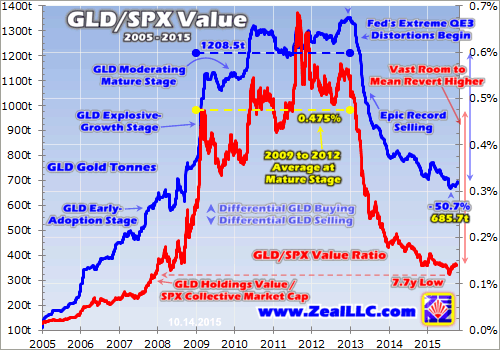
It took about 100k pieces of data to build this chart, and the results are super-bullish for gold investment demand going forward. Per the proxy of looking at the value of GLD’s holdings compared to the total market cap of the S&P 500 companies, American stock investors’ portfolio exposure to gold right now is around just 0.14%! That’s not a typo, we are talking about 1/7th of a single percentage point here, nothing.
Thanks to that extreme gold-futures shorting attack back in July, this ratio of the values of GLD to the S&P 500 fell as low as 0.12% in early August. That happened to be a major secular 7.7-year low in this measure of gold investment. Once again like all extremes, this one isn’t sustainable. Gold can’t and won’t stay loathed forever, and as it mean reverts higher out of these lows investors will start returning.
And reasonable normal levels of GLD investment are far higher than today’s dismal lows. Once again in those last normal years between 2008’s stock panic and the early-2013 dawn of the Fed’s incredibly-manipulative QE3 campaign, 2009 to 2012, American stock investors’ portfolio exposure to gold via GLD averaged near 0.48%. That long 4-year secular span is a rock-solid baseline, not a fleeting gold-euphoria moment.
In order to merely mean revert back to that normal-year average, not even overshoot, this ratio would have to soar 3.4x from current levels! That means a lot of stock-trader capital flowing into GLD, a lot of gold-price appreciation, and probably plenty of general stock-market selling thrown in to boot. Again using that normal-year average span between 2009 to 2012, we can get a decent idea of how much of each.
After GLD’s holdings grew rapidly in its early years as stock traders warmed to the concept of a gold ETF, and then experienced explosive growth just after 2008’s stock panic as hedge-fund managers flooded into cheap gold, GLD’s holdings hit a mature stage in early 2009. They had finally reached an equilibrium where they could keep gradually growing on balance, but were too large for more fast growth.
During that 4-normal-year span before QE3’s gross distortions, GLD’s gold bullion held in trust for its shareholders averaged 1208.5t. As of this week, its holdings languished way down at 694.9t which wasn’t far above their major 6.9-year secular low of early August. So a normalization in GLD’s holdings to pre-QE3 levels would require enough differential buying pressure on GLD’s shares to necessitate 513.6t of gold buying.
That’s an incredible amount of gold that would catapult GLD’s holdings nearly 75% above today’s low levels. I don’t know how long this full mean reversion would take, but let’s conservatively assume a couple years. That would equate to GLD bullion buying of 21.4t a month over that span. That would be a big boost to global gold investment demand, which ran at 75.7t per month in the first half of 2015 per the WGC.
So we are talking about a 28% boost in worldwide gold investment demand for a couple years as American stock investors reallocate capital to GLD to reverse their radical gold underinvestment. The amount of capital necessary to fuel this is vast by gold standards, but still small by stock-market ones. Between 2009 and 2012, the gold price averaged $1361. The midpoint between here and there is near $1275.
Buying the 513.6t of gold bullion necessary to mean revert GLD’s holdings back to normal would cost about $21b at $1275 gold. And $21b in differential new inflows to GLD from American stock investors would work wonders for gold’s price, bidding it much higher. The sheer capital shift necessary to fully unwind today’s radical gold underinvestment is super-bullish for gold price levels in the coming years.
And stepping back, seeing a 0.5% portfolio allocation in gold again by American stock investors certainly isn’t a stretch at all. Remember the average ratio of GLD holdings’ value to the S&P 500 collective market capitalization was 0.48% for 4 years between 2009 to 2012. At its height in August 2011 as gold soared to a euphoric, overbought peak, this ratio challenged 0.69%. And 0.5% still remains very low historically too.
For centuries it not millennia, prudent investors have advocated having at least 5% of total portfolios invested in gold. That’s 10x the conservative target for this coming mean reversion! Gold is a unique portfolio diversifier that generally moves contrary to stock markets. It acts as essential portfolio insurance against some massive selloff hammering the other 95% of portfolios. Literally every investor should own gold!
And there’s no doubt many more will in the coming years. Everything that’s happened since 2013 in the markets is a central-bank-conjured fiction, a fantastic illusion from zero interest rates and extreme QE money printing. The vast resulting distortions artificially boosted stocks while sucking great amounts of capital out of other investments including gold. Neither extreme of high stocks or low gold is sustainable.
As the Fed’s extraordinary stock-market levitation inevitably rolls over into a new cyclical bear, investors will seek out alternatives again. Since gold tends to thrive in weak stock markets and rallies during bear markets, it will again become a prime destination for countless investors. So not only is that very conservative 0.5% stock-investor portfolio allocation to gold easily doable, that metric will probably go much higher.
And don’t make the mistake American futures speculators are of fearing the Fed’s coming rate hikes. Historically gold has actually thrived on balance in Fed-rate-hike cycles, primarily because they wreak so much havoc on general stocks and bonds. Gold actually rallied through 6 of the 11 Fed-rate-hike cycles since 1971, with average gains of a staggering 61.0% within those exact rate-hike-cycle spans!
During the Fed’s last rate-hike cycle between June 2004 to June 2006 where it more than quintupled its federal-funds rate from 1.00% to 5.25%, gold soared 49.6% higher! That was despite 425 basis points of hikes across 17 consecutive FOMC meetings. Gold only fell in Fed-rate-hike cycles when they began when gold was near secular highs, for an average of just 13.9%. That obviously certainly isn’t the case today.
So don’t hesitate to heavily invest in gold now before the legions of American stock investors figure out they are radically underinvested. Their vast buying will catapult gold much higher. Either physical gold bullion or GLD shares are fine, but I far prefer the beaten-down stocks of the gold miners. They’ve been forced to fundamentally-absurd lows in recent years, and have big potential to at least quadruple in the next few!
And that’s why you need us at Zeal. We’ve long specialized in this obscure contrarian sector that most mainstream investors ignore, despite gold stocks multiplying wealth by nearly 18x in the 2000s! We’ve long published acclaimed weekly and monthly newsletters for contrarian speculators and investors. They draw on our decades of exceptional experience, knowledge, and wisdom to explain what’s going on in the markets, why, and how to trade them with specific stocks. That’s proved very profitable.
Since 2001, all 700 stock trades recommended in our newsletters have averaged annualized realized gains of +21.3%. And we currently have a couple dozen new gold-stock and silver-stock trades on our books just purchased in recent months as gold stocks languished at ridiculous levels due to irrational hyper-bearish sentiment. They already have unrealized gains of up to 56%, and this major new gold-stock upleg is just getting started. Don’t procrastinate any longer, subscribe today and get invested!
The bottom line is American investors remain radically underinvested in gold. This is readily evident in the ratio of the value of GLD’s gold-bullion holdings to the collective market capitalization of the elite S&P 500 stocks. Portfolio allocations to gold were recently at their lowest levels in nearly 8 years, and remain at well under a third of recent years’ average levels before the Fed’s wild distortions from QE3.
That means American investors are going to soon plow tens of billions of dollars back into gold in an attempt to regain some modicum of prudent portfolio diversification. While these capital flows will be small compared to the stock markets, they are massive relative to gold investment demand. All that buying is going to catapult gold prices far higher, leading to gargantuan gains in the left-for-dead gold miners’ stocks.
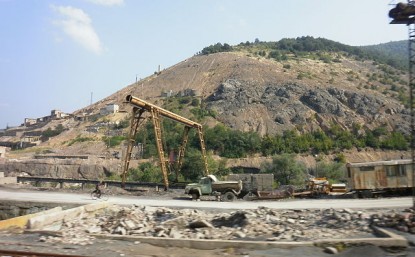
For the past two weeks I have written to my premium subscribers to look at copper and the industrial metals as I saw deep pocketed private equity funds and billionaires such as Carl Icahn and KKR taking big bets on beaten down Dr. Copper hitting five year lows. I knew that a bottom could be forming and that we could be near the final turn. It was my first copper bet in many years.
Now it appears that the call of a bottom in copper and industrial metals could be confirmed by the recent news that Glencore is cutting global production of zinc. Copper and nickel could be next. The Commodity Giants such as Glencore are in great financial duress right now shutting down mines left and right that are losing money at these low commodity prices. They recently shut down two African Mines.
Other industrial metals most notably copper are also rising as the recent downturn in prices has forced many of the high cost mines to shut down as well as the companies could not turn a profit. The news out of Glencore over zinc is also shocking the copper market highlighting the painful effects of this commodity crash as even the giants have fallen. There is a coming supply shortage coming to the commodity markets which could be unparalleled as the major miners have been absolutely devastated in this historic downturn. Here are some recent companies I have purchased as an investment and have welcomed on my website as an advertiser. I am highly selective of companies and I believe they have exciting stories to tell to my readers.
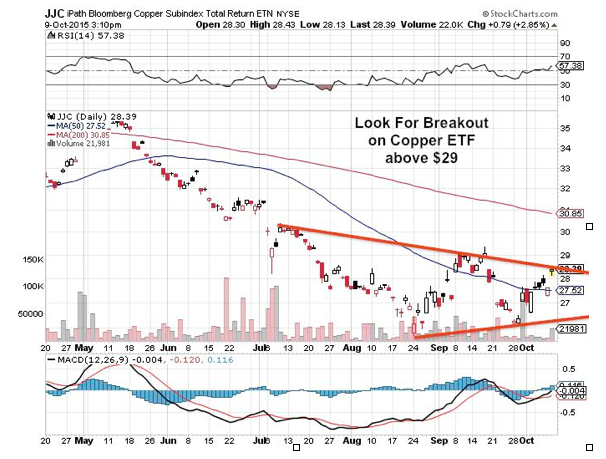
1)Attention should be paid to Excelsior Mining (MIN.V or EXMGF) who just announced that they purchased out of receivership an adjacent Copper Mine to their Gunnison Project in Arizona and will be raising $12 million USD. The Mine comes with a working solvent extraction plant which could process solutions from Gunnison saving time and money to get into production. Commenting on the Johnson Camp Transaction, Stephen Twyerould, President and CEO of the Company, said, “This is expected to allow us to significantly reduce our upfront capital requirements and the time required for the start-up of the Gunnison Project. The Company also intends to thoroughly examine the potential of Johnson Camp, especially since this is the first time in its 130 year history that the entire Johnson Camp district has been consolidated under one ownership.”
Excelsior’s Gunnison Project is possibly the lowest cost and most advanced project in the US in control of a junior miner at the Prefeasibility stage. Because of the uniqueness of the project copper can be recovered through In-Situ Recovery. I have learned about ISR from the uranium sector most notably from the low cost ISR producer Uranerz Energy which was acquired by Energy Fuels (OTC:UUUU) earlier this year.
See the full news release on Excelsior’s Johnson Camp acquisition and financing by clicking here….
See my recent interview with Excelsior Mining (MIN.V or EXMGF) CEO Stephen Twyerould by clicking here…
2)Keep a close eye on Uranium Resources (NASDAQ:URRE) whose merger with Anatolia is deeply supported by both sides. This new deal could make URRE a near term low cost producer with the Temrezli Project. Cost savings were impressive and the company could be well positioned after the consolidation for the coming upturn in uranium prices. Don’t forget URRE has many idled projects in the US which could also provide leverage to a rebound in uranium prices. In the meantime, URRE will now have the Temrezli ISR Project which is at the Feasibility Stage and could be a profitable project even at these low uranium price levels. Merger should close around November 9th.
See the news release showing overwhelming support from Anatolia and URRE shareholders by clicking here…
See my recent interview with Uranium Resources (URRE) CEO Chris Jones by clicking here…
3)An earlier stage nickel explorer in Voisey’s Bay Equitas Resources (EQT.V) continues to excite me and grab the attention of the junior mining investment community. They recently acquired additional claims to the west of their Garland Property which the company is currently drilling. VP Exploration of Equitas (EQT.V) Everett Makela recently stated in the press release, “I am pleased with the progress of the Phase 2 campaign to date..The three additional anomalies at O, P and Q increase our odds for success, and we are adjusting the program to accommodate exploration of these targets. Recent interpretation of the multi-km Southern Response Trend has led to a shift of exploration focus to this area. We will continue to provide updates on results as they become available”. Mr. Makela worked with Inco and Vale on nickel exploration and is a specialist in target generation and managing exploration programs.
See the recent update on exploration at Garland by clicking here…
See my recent interview with Equitas (EQT.V) CEO Kyler Hardy by clicking here…
Disclosure: I own shares in MIN, URRE and EQT. They are all website sponsors so I do have a conflict of interest as I would benefit if the share price increases. This is not financial advice. Please do your own due diligence as there are many risks.
Disclosure: I am/we are long EXMGF, URRE, EQTRD.
Additional disclosure: These stocks are also advertisers on my website Goldstocktrades.com

Is gold finally beginning to brighten? Some analysts believe that the Federal Reserve’s difficulty in raising rates is liable to give the gold price a bump.
A recent article at Couriermail.com.au announced that gold may be “tipped to bounce to US$1,500” within the year. Jordan Eliseo, chief economist at Australian Bullion Co, is quoted as saying that the current tightening cycle might only see a few hikes, in which case it might become clear that the era of easy money is far from over.
Fat Prophets CEO Angus Geddes believes the Fed is going to be moderate regarding hikes. He also believes the European Central Bank is likely to extend its quantitative easing program.
“I think though with gold in $US also going up, we could well see the Australian dollar price of gold at $A2000 within six months,” Geddes is quoted as saying.
“Bank analysts [are] warming up to gold,” states a headline at Newsmax. The article explains, “Major banking houses have been chilly toward gold for some time, but there are signs some of them are warming up to the yellow metal.”
India Ready to Expand Gold Mining
Meanwhile, one of the most important gold-buying countries is getting ready to increase its domestic supply.
After attempting to combat India’s desire for physical gold with little success, the administration of Narenda Modi is reportedly opening up gold mines and opening promising geological formations for exploration.
A recent article at Oilprice.com announced, “India’s gold mining sector could experience a massive renewal soon.” The article pointed out that “India is continuing to push for ways to increase its gold supply.”
Officials from the country’s mining ministry have been quoted as saying they could “auction up to 80 more historic gold mines around the country.” There is reportedly interest in reopening such legendary mines as the Kolar gold mine that began operation in 1880.
From a geological standpoint, India exhibits promising geology. The kinds of archean cratonic rocks that have produced a wealth of precious metals, as well as copper, nickel and other metals in Canada, Russia and Brazil, are said to be present in India as well.
Anthony Wile, Other Bears, Still Pessimistic
There are many who remain bearish, of course. Anthony Wile, Chief Investment Strategist for High Alert Investment Management Ltd., doesn’t believe gold will receive much of a boost from India’s recent moves – or from the perception of a dovish Fed, either.
“I’d be happy to see a sustainable recovery in the gold price and believe our current monetary system is inevitably going to collapse,” Anthony Wile says. “I’ve been on record since autumn of 2011 as saying that the trend for speculative gold stocks is basically not a positive one – regardless of the underlying price. Unlike in previous ‘gold booms,’ the mining sector hasn’t heated up as expected during the gold bull of the 2000s. People who want to speculate in paper gold are doing it through ETFs, not gold mining companies.”
For Wile and other such observers, the efforts of the Indian administration to provide more native gold are probably not going to spark a near-term gold rush, and even Fed moderation may not help the sector. “I’d love to be pleasantly surprised,” Wile says. “You can call me a reluctant bear.”
Modi to Be Successful Cutting Imports?
Despite the sentiments of bears like Anthony Wile, it may not be easy for Modi to reduce India’s demand for physical gold.
Modi has often pointed out that large imports of the yellow metal aggravate India’s negative trade balance. By increasing India’s domestic production, Modi hopes to reduce imports. He recently came up with two other ways of lowering physical demand: sovereign gold bonds and gold monetization.

Since gold doesn’t pay a return, the administration has decided to make sovereign gold bonds available at interest. Now instead of holding “useless” gold, people can cash in their gold and buy interest-bearing bonds at around 3%.
Gold monetization involves the private sector. Here, the scheme allows people to provide their bullion or jewelry to a bank that will hold it while paying the owner perhaps 3% in interest, tax-free.
Modi is fighting hard to reduce holdings of physical gold. However, gold demand in India may go up by as much as 15% during the upcoming festival season, according to reports. Consumption may reach an estimated 230 tons, which would be the most since 2012.
The Modi administration probably won’t succeed in cutting the demand for non-domestic gold but will stimulate India’s moribund gold mining sector.
Modi’s experience with gold in India therefore mimics the larger scenario for gold. There is continued demand for the yellow metal and even upward price pressure. However, there are countercurrents that weigh down progress.
For every analyst like Geddes that sees an optimistic price picture, there are cooler heads like Anthony Wile that warn the trends remain mixed.
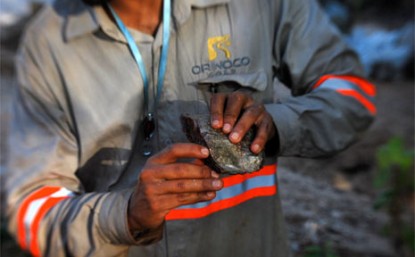
My prior article on Orinoco Gold (ASX:OGX) (OGX:ASX) (OGX.AX) was on August 12th when the stock traded at A$ 0.09 per share. Recall, Orinoco Gold is an Australian (ASX-listed), Brazilian-focused gold company. The Company is targeting first production from its 70% owned, high-grade Cascavel Gold Project within 4-5 months. What’s happened at Orinoco since my article in August? Essentially nothing. End of story? No. The absence of bad news for a soon to be producing gold company in Brazil or elsewhere is actually very good news. Orinoco is on time and on budget with a cash cushion for unforeseen contingencies.
When MD Mark Papendieck talks, people listen…. and buy shares
I wish I could claim that my compelling article in August sparked a 100% gain in the share price, but that would not be true. The spotlight largely belongs to Managing Director Mark Papendieck who has tirelessly spent the past several weeks on the road telling and retelling the story. Obviously, Mr. Papendieck has a very good story to tell and expertly articulates it. Behind the scenes, but equally important, is Papendieck’s management team and Board who share in the lofty accomplishment of generating no bad news. Recall that 9 of the 12 listed personnel on Orinoco’s website have either direct exposure to Brazil or are long-time experts in mining or both. [Please see list of Management & Board members.] As yet another reminder, please consider the credentials of Orinoco Gold’s Co-Founders. [Note: passage from my prior article]
Managing Director, Mr. Mark Papendieck, Diploma of Law from the NSW Legal Practitioners Admission Board (Dip. Law, NSW LPAB).
Chief Geologist, Dr. Marcelo De-Carvalho, (Metalogeny), PhD (Metalogeny & Geochemistry), CREA.
President Brazil Operations, Dr. Klaus Peterson, M.Sc (Mineralogy & Petrology), PhD (Mineralogy & Petrology), AusIMM, CREAM.Sc (Mineralogy & Petrology), PhD (Mineralogy & Petrology), AusIMM, CREA.
Not only is Cascavel shovel ready, permitted and funded through to production, it’s also a high-grade gold mine. How high grade?
The Cascavel Project hosts high-grade, structurally-controlled coarse gold shoots, where underground sampling has returned bonanza grades including 15 metres grading 88 grams of gold per tonne. Bulk samples from the Cuca winze (350m north) and the nearby Mestre winze (90m south) have recorded grades of 27g/t gold (2.8 tonnes) and 39g/t gold (500kgs) respectively.
Country risk largely behind Orinoco, fruits of team’s labor within reach.
Usually a bullish article on a company would try to sneak the risks factors in at the end of the article, if addressing them at all. Instead, I will comment on what I believe investors are most concerned about, country risk, (Brazil). It’s true that the country in question is not a top-tier mining destination, but please note three things. First, the State of Goiás in central Brazil is known to be one of the better parts of Brazil to operate in. Second, Orinoco Gold is successfully working in a collaborative manner with ALL stakeholders, not just shareholders.
Third, gold Majors such as Yamana Gold and AngloGold Ashanti have had multiple successes in Brazil. Consider Brio Gold, a subsidiary of Yamana. It holds 2 operating mines, Pilar & Fazenda Brasileiro and C1 Santa Luz, a constructed mine to soon to be re-commissioned. Brio is the real deal, with total gold production this year of up to 130,000 ozs + 100,000 ozs upon the re-commissioning of C1 Santa Luz next year.
Yamana also has a low-cost Chapada open pit gold-copper mine, located in Goiás State, (same State as Orinoco), and the Jacobina mine located in Bahia state in northeast Brazil. Back to Orinoco Gold, a reason for the cheap valuation is country risk and a lack of a JORC compliant resource. If those factors were no longer present, the company’s valuation would probably be twice that of today’s.
Ultimately though, the best evidence of Orinoco Gold successfully combating country risk is demonstrated by the fact that it’s merely 4-5 months from first gold! So, yes there’s country risk, but Orinoco has painstakingly traversed it and will be the next gold producer in Brazil. Any country risk now falls squarely on the shoulders of other juniors further away from production.
Valuation Exercise
In August I explained why I thought, “Orinoco Gold could be one of the cheapest risk-adjusted juniors on the planet.” How about today, with the stock having doubled? The market cap is now ~ A$ 35 million = ~ C$ 32.5 million = ~ US$ 25 million. While the valuation is less attractive, there remain catalysts for the stock price to continue upwards. Articles and interviews by myself and others and more importantly the Orinoco team getting out to tell the story means that the stock still has legs. Gold companies almost always see increased valuations in the months leading to production.
Assuming a successful first pour and a relatively trouble-free ramp up to stage 1 production of ~ 20,000 ounces (14,000 net to Orinoco), the Company could reach positive cash flow next year. In addition to excess cash to re-invest towards the goal of ramping up, over time, to stage 2 production of ~ 40,000 ozs, (28,000 net to Orinoco), there’s a decent chance that equity dilution could be mitigated. With an impressive pipeline of projects described in my prior article, and possibly reduced equity dilution, especially compared to junior gold mining peers, I strongly suggest that readers and investors alike take a closer look.
Orinoco Gold has strong upside to an increase in the price of gold. In fact, many have commented on metals & minerals producers in Canada & Australia benefiting from their respective weak currencies vs. the U.S. dollar. For better or worse, the Brazilian real is down significantly more. The CAD$ is down 11% year-to-date, the AUZ$ 12% and the Brazilian real down a whopping 32%.
Conclusion….
The gap between producers and developers is widening as access to development capital continues to be difficult if not impossible to obtain. I believe the closer that Orinoco Gold gets to first production in 4-5 months, the lower the Company’s risk and the higher the Company’s share price, all else equal. I believe that Orinoco should exhibit relatively low correlation to the major stock indices. Some advanced explorers and developers, still requiring large cap-ex checks to be written, may never cross the finish line. There’s virtually no risk of that happening here. An interesting question, do advanced exploration and development companies truly have leverage (exposure) to the gold price? I would say no, even though some claim they do. On the other hand, Orinoco does have upside to an increase in the price gold and from reaching production early next year. That’s 2 near-term catalysts other non-producers don’t share. The fact that Orinoco Gold can cross the finish line without meaningful equity dilution is all the better.
Orinoco Gold (Ticker: ASX:OGR) (OGR:ASX) is a speculative, small cap company, with limited trading volume. An investment in Orinoco Gold is not suitable for all investors. Readers and investors are encouraged to do their own due diligence before buying or selling stocks, especially small cap stocks. Due diligence should include consulting with one’s own investment advisor. The author, Peter Epstein,CFA, MBA owns shares of Orinoco Gold. Mr. Epstein is not a registered financial advisor. Readers should take this fact into careful consideration.
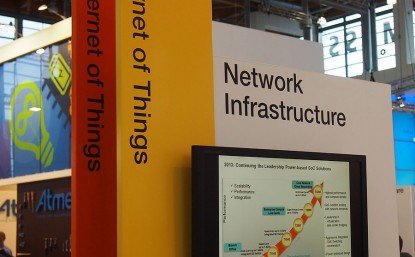
While most of us know and use the internet in a variety of ways every single day, we also interact on a much more digital level through what’s called the Internet of Things (IoT for short). The Internet of Things is a network where interconnected devices communicate with one another. Through the use of sensors and digital technology, devices are able to remotely connect and share information with one another, which is the broad concept of IoT technology.
Everyday household devices have been revolutionized by the IoT. Consider being able to send data to a printer while in another room or being able to talk hands-free via Bluetooth in your car – this kind of technology represents just the beginning of the new IoT world.
The Internet of Things isn’t a new concept. In 1989, an internet-connected toaster was introduced at the Interop Technology Expo in Las Vegas. Although it was considered a novelty at the time, inventors knew they had stumbled on something with great potential. Twenty five years later, we are standing on the cusp of an interconnectedness that’s never been seen before.
This technology isn’t just for individual consumers — it’s also helping reshape vital industries that at first glance seem far outside the scope of the internet and advanced networking.
Consider, for example, Ambyint, a Calgary-based tech firm that’s brought the advanced technological applications of IoT to Canada’s oil and gas sector. “Ambyint’s technology allows oil and gas producers to not only operate more efficiently, but to also better understand the obstacles in their way to greater efficiency,” Nav Dhunay, President and CEO of Ambyint, explained. “At Ambyint, we’ve created a product that delivers big data analytics to the oil patch, using a device that’s no larger than a cell phone.”
With a long history in developing tech startups, Nav Dhunay believes the possibilities for IoT applications are almost limitless. “These technologies have the potential to transform and modernize a wide span of industries; we’re not just talking about technology-based industries,” said Dhunay.
He also pointed out the ecological benefits that IoT offers. “Better efficiency in the oil and gas sector is a benefit to the environment,” Nav Dhunay added. “Interconnected technology can also radically improve response time in the event of an oil or gas well emergency.”
Through IoT, inherently dangerous industries like mining can also be made much safer than before. Sensors could warn of impending cave-ins and weak points. Mining companies will also have the ability to find the minerals and precious metals they are looking for with more precision and accuracy than ever before. “Mining needs this technology,” writes industry analyst Kelly Prowse in Techvibes. “But, many companies haven’t yet realized the potential for long term cost reductions in ore targeting and processing, energy management and maintenance – key industry woes.”
Early adopters are reaping the benefits of embracing new technology; after all its been shown that big data and IoT systems can reduce energy expenditures by as much as 40 percent. This is an enticing proposition for mining companies who are looking to cut spending across the board, particularly in the current price environment.
Last summer, over 70 industry executives from around the world were surveyed, and the majority of executives reported feeling ‘highly optimistic’ about the future of mining and technology. With total spending on information and communication technologies in the mining sector projected to top $26.1 billion by 2018, their optimism can be further bolstered.
The boundaries to the possibilities of IoT applications are only limited to human creativity. Nevertheless, IoT is about to change the way we interact with the world, one another and technology, all for the better.
If you would like to receive our free newsletter via email, simply enter your email address below & click subscribe.
CONNECT WITH US
Tweets
Tweet with hash tag #miningfeeds or @miningfeeds and your tweets will be displayed across this site.
MOST ACTIVE MINING STOCKS
Daily Gainers
 Lincoln Minerals Limited Lincoln Minerals Limited |
LML.AX | +125.00% |
      |
GCR.AX | +33.33% |
      |
CASA.V | +30.00% |
      |
AHN.AX | +22.22% |
      |
ADD.AX | +22.22% |
      |
AZM.V | +21.98% |
      |
NSE.V | +21.05% |
      |
DYG.V | +18.42% |
      |
AAZ.V | +18.18% |
      |
GLA.AX | +17.65% |


 Follow us on Twitter
Follow us on Twitter Become our facebook fan
Become our facebook fan








